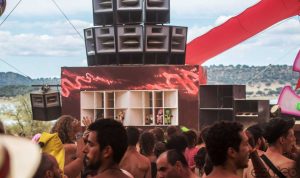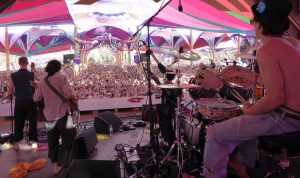SPEAKERS
TOURING
VERO
VERO VX
EVO T
INSTALL
VXI
EVO
DANCE STACK
RESOLUTION
BASS
COMPACT
REFLEX
HORN LOADED
COMPACT SERIES
MONITOR SERIES
This big mass of sound and light is the largest of the sector and gathers thousands of audio professionals, on the lookout for the most relevant technological breakthroughs. A wide choice of workshops, new products’ presentations, conferences and events are open to attendees, and our brands definitely will have lots of exciting news to share.
For instance, Full Fat Audio will reveal a significant technological evolution which should be pleasing to everyone (stay attuned and keep up to date ;-), and Funktion One will officially launch EVO ! A range of speakers which has been severely tested last summer during the BOOM festival. On this matter, an 8 pages article was published in the SONOMAG of November 2014. Here is a selection of extracts.

A LITTLE HISTORY
Located on the frontier between Portugal and Spain, on the banks of Lake Idanha-a-Nova, the Boom Festival is intended to be a celebration of freedom of spirit which revolves around psychedelic music, art, culture and a great deal of love. The week-long festival, which began in 1997, claims to be able to induce profound changes within those who come with this in mind.
The entrance fee, which amounts to €200, is paid by more than 42,000 festivalgoers. Added to this price are the daily expenses for accommodation on one of Boom’s many campsites, along with food sold in the dozens of stalls. At the same time, all the water is recycled, there are composting toilets, the electricity is produced in part by renewable energy and almost the entire infrastructure is made from natural, biodegradable materials. Boom is a collective dream, rigorously organised by a very professional team.

A MEGA HORN FOR A MEGA FESTIVAL
The huge wave-guide extension added to lengthen the flare of the horn-loaded subs has been made to measure by the festival carpenters. To be effective for this operation, it’s optimised for frequencies down to 30 Hz. This takes the technique of the wave guide, notably the ability to project acoustic energy, and uses it at the extremely low frequencies produced by the subs.
The exit dimensions are 4 metres wide by 1.8 metres high. “Although we could have used other similar sizes without anything changing very much” Tony adds, “In a wave-horn designed for very low frequencies, the fundamental point is that it the structure must be very robust and inert. By default, a great deal of energy is lost to vibration of the materials.” Four horns have been installed along the length of the stage.
Tony claims that three would have sufficed, but then we come to their alignment. “We don’t use any equalisation and the crossover is the same for all the circuits. The only point that differs between them is the delay, which we have optimised separately to better control the even distribution of the sound. We’ve also added two subwoofers on the sides. This was necessary because the directivity offered by the size of these wave-horns means that the bass notes are projected forward along a corridor in front of the stage and the areas to either side are out of the coverage zone. These quiet zones needed to be improved from a bass point of view.
The addition of two sub stacks has also enabled us to experiment in a number of different ways by applying time delays to the different stacks and horns. As a first step, we delayed the signals in order to achieve a “standard” time alignment. In a way, this means extending the shape of the acoustic field of the main subs. And this didn’t work. We didn’t gain much more bass at the sides and we lost some impact in the area of the main subs. Then we tried it, with the same delay, on the lateral subs as/and on the front subs. The acoustic field of the lateral subs is then ahead of that of the central subs, and turned out to work very well. Sometimes you need to know how to go beyond the theory!”

POINT SOURCE
Funktion One stands up for the relevance of its point source systems at a time when other manufacturers swear by line arrays. It seems to me that I have the perfect person on hand to argue the case, Tony Andrews: “Let’s start with a little nostalgia. Despite, or maybe even thanks to, the technology available at the time, Jimi Hendrix’ concerts have remained absolutely unforgettable for those who attended them. And the sound systems were point sources. With point source systems, whatever the position from which you are listening to the sound, you hear it, consistently, from speakers pointed towards you. With a line array system you’re going to hear the sound from maybe ten or fifteen speakers and the signals you perceive will all arrive at different times. And the brain’s capacity to locate the origin of these sounds by means of these slight delays is extremely well developed; the accuracy of this analysis allows it to detect differences of 15 to 20 μs. If the same sound comes to the ears a number of times with a time lag of more than 20 μs, the brain will identify multiple sounds. This successive perception of the same sound contributes to the destruction of the transitional elements of the sound. We know that it is essential to reproduce these transient elements accurately: if you listen to a violin playing without having heard it come in at the beginning, you will find it very difficult to distinguish it from that of another instrument. In short, the sound that originates from a line array can never be as “fascinating”, or authentic, as one from a good point source”

THE SOUND OF BOOM
Funktion One has found an alter ego here, receptive to the approach that the brand stands for: to offer the most respectful, accurate and detailed sound that a sound system is capable of delivering. And the result lives up to this aim. The last tests on site before the arrival of the public allowed me to appreciate the excellent spectral balance, just as much as the extremely efficient directivity of the “bass cannon” effect produced by the Mega Horns. No matter where you are within the Dance Temple’s 6000 square metres, just the right balance is struck, at a distance as well as at right beside the subs, where the Res1.5 mid high horns faithfully fulfil their purpose of front-fills. An investigative trip underneath the stage also brings its share of information. Just as Tony had led us to believe, the sound energy from the Mega Horns is almost entirely projected towards the front. Whilst the pressure in front of the subs is, let’s say, inhuman, you can stand right behind the speakers and almost talk normally, without raising your voice. Another demonstration of the hig=hly efficient bass distribution,
A further point is that the system proved during the live sets that it is able to produce a sound combining loudness with precision, whilst avoiding all aggression; a form of musical presence, both natural and authentic. During the DJ sets I heard, as always, the best and the worst, depending on the quality of the sound sources. And the system has to cope with that.
I didn’t want to leave the Boom Festival without tipping my hat to Funktion One, Solution One and their teams. After many days of setting up, they remained in good spirits whilst meeting the needs of the artists for 20 hours a day throughout the whole festival.
